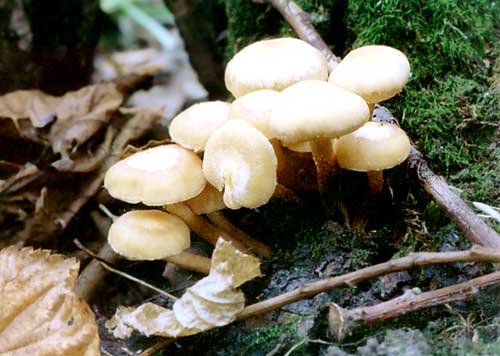Summer Opyonok (Kuehneromyces mutabilis)
- אָפּטייל: Basidiomycota (Basidiomycetes)
- סאַבדיוויזשאַן: Agaricomycotina (Agaricomycetes)
- קלאַס: Agaricomycetes (Agaricomycetes)
- סובקלאַס: Agaricomycetidae (Agaricomycetes)
- סדר: אַגאַריקלעס (אַגאַריק אָדער לאַמעללער)
- משפּחה: Strophariaceae (Strophariaceae)
- Genus: Kuehneromyces (Kûneromyces)
- טיפּ: Kuehneromyces mutabilis (Опёнок летний)

זומער האָניק אַגאַריק (לאַט. Kuehneromyces mutabilis) is an edible mushroom of the Strophariaceae family.
Summer honey agaric hat:
Diameter from 2 to 8 cm, yellow-brown, strongly hygrophanous, lighter in the center (in dry weather, color zoning is not so pronounced, sometimes absent at all), first convex with a tubercle in the center, then flat-convex, in wet weather sticky. The pulp is thin, light brown, with a pleasant smell and taste. It often happens that the mushroom caps of the “lower tier” are covered with a brown layer of spore powder from the upper mushrooms, and it seems that they are rotten.
רעקאָרדס:
At first light yellow, then rusty-brown, adherent to the stem, sometimes slightly descending.
ספּאָר פּודער:
טונקל ברוין.
Summer honey agaric leg:
Length 3-8 cm, thickness up to 0,5 cm, hollow, cylindrical, curved, hard, brown, with a brown membranous ring, dark brown below the ring.
צעשפרייטן:
The summer honey agaric grows from June to October (it bears fruit abundantly, as a rule, in July-August, not later) on rotting wood, on stumps and deadwood of deciduous trees, mainly birch. Under the right conditions, it occurs in large numbers. Rarely found on coniferous trees.
ענלעך מינים:
According to foreign experts, first of all, one should remember about the bordered galerina (Galerina marginata), which grows on the stumps of coniferous trees and is poisonous, like a pale toadstool. Due to the strong variability of the summer honey agaric (no wonder it was called “mutabilis”), there are actually no universal signs by which it should be distinguished from the bordered galerina, although it is not so easy to confuse them. In order to avoid accidents, summer mushrooms should not be collected in coniferous forests, on the stumps of coniferous trees.
In dry weather, Kuehneromyces mutabilis loses many of its characteristics, and then it can be confused with literally all mushrooms that grow in similar conditions. For example, with winter honey agaric (Flammulina velutipes), sulfur-yellow false honey agaric (Hypholoma fasciculare) and brick red (Hypholoma sublateritium), as well as with false gray lamellar honey agaric (Hypholoma capnoides). Moral: do not collect overgrown summer mushrooms, which no longer look like themselves.
עדיביליטי:
Considered very good עסן שוועמלespecially in Western literature. In my opinion, it is really very good in a boiled, “lightly salted” form. Lost in other species.









